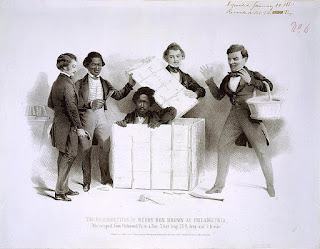Monday, September 27th, 2010
Henry "Box" Brown’s Moving Panorama
Have you ever picked up a book and pleasantly discovered that the reading was more interesting than you anticipated? I recently read The Unboxing of Henry Brown by Jeffrey Ruggles, and I ended up feeling that way. I’m very interested in issues of slavery/antislavery in the United States (and elsewhere), and for a long time I’ve wanted to learn more about Henry “Box” Brown. I didn’t anticipate reading about art history when I picked up this book, though, but was excited to find a lot of discussion about the moving panorama, a popular form of art (and entertainment) in the mid-19th century.
Before reading this book, the only thing I knew about Brown was his escape from slavery: he climbed into a box and shipped himself from Virginia (a “slave” state) to Philadelphia (a “free” state). Various images of Brown’s “resurrection” from his box (the one above is from Boston, 1850 (unsigned)) were used by abolitionists. One art historian commented that these images of the unboxing were “perhaps the most potent single metaphor [that abolitionists used] for the displacement of the traditional image of the ‘runaway’ slave in popular imagination.”1
The thing that surprised me most about this book, though, was to learn how Brown decided to earn a living after escaping from slavery. Brown commissioned a moving panorama to be painted, which he titled Mirror of Slavery.2 Moving panoramas consisted of huge canvases (sewn together) which were displayed on a type of vertical spool. The paintings could then be scrolled in front of an audience, revealing a sequence of scenes. In some ways, the moving panorama was the predecessor to the slide show. (If you like, you can get a sense of the moving panorama idea by watching the beginning of this scene from the film “Letter from an Unknown Woman,” 1948). During the middle of the 19th century, the moving panorama was an extremely popular form of entertainment. It’s sad that few moving panoramas exist today. Those that do exist are never shown in their original format, either, largely due to conservation issues.
A good portion of Ruggles’ book discusses the history of the moving panorama (as a type of art) and the scenes which appeared on Mirror of Slavery. Although Mirror of Slavery doesn’t exist today, it was interesting to learn about the subject matter for the scenes. We also have a basic idea of the composition for some of the Mirror of Slavery scenes too, since it’s obvious that Mirror of Slavery found inspiration in the illustrations for the Charles Green’s book The Nubian Slave. Ruggles book is replete with lots of images that may have resembled the scenes from Mirror of Slavery.
Anyhow, for several years Brown traveled around the United States and England, giving presentations and lectures while exhibiting his moving panorama. I have to admit – while I was very interested to learn about Brown’s life, I found it even more fascinating to learn more about the moving panorama. Although I was familiar with the idea of the moving panorama before, I didn’t realize that such an artistic device helped to aid the antislavery movement.3
1 Marcus Wood, Blind Memory: Visual Representations of Slavery in England and America, 1780-1865 (Manchester, England: 2000), 103. (See text online here.)
2 Henry “Box” Brown’s moving panorama was painted by three painters from Boston, with the primary artist probably being Josiah Wollcott. The other artists are described in an 1850 newspaper from Liverpool as “Rouse and Johnson.” Ruggles suggests that these artists might have been Samuel Worcester Rowse and David Claypoole Johnston. See Ruggles, p. 75.
3 Henry “Box” Brown was not the only person to use the moving panorama to discuss slavery. Ruggles mentions a couple of others who also produced moving panoramas, including the black abolitionist William Wells Brown. See Ruggles, p. 72.

I think it is so neat that you read this book! And, like you said, how incredibly cool that it would have even more to it than what already would make it an interesting story with the moving panorama.
So, what perception did you get from the book in terms of Brown and his panorama? Do you think he commissioned it because of the impact of his escape from slavery or to possibly further his celebrity? It's kind of interesting that moving panoramas are, like you said, an early version of a slide show. It could also be argued that they are the predecessor for power point (but certainly much more entertaining!)!
I think his story is fascinating, but it also makes me feel disappointed when I think of his wife and family that he left behind/replaced with a new one …
Well that sounds like the start of a dissertation right there. 🙂
Yeah, e, I thought it was sad that Brown didn't try to free his wife and children from slavery. It's thought that his new wife was probably a white Englishwoman.
Actually, Brown's dishonesty regarding his intentions to remarry caused a permanent rift between him and his long-time business partner. I hope he felt some remorse for how he acted (not only to his business partner, but to his first wife).
Ha! I don't think this would be my dissertation, heidenkind, but it would be an interesting topic! 🙂
Hey, guess what we talked about in class tonight? Moving panoramas and how they depicted the journeys of John C. Fremont and a few other explorers.
What ironic timing, heidenkind! Wow, I didn't know that Fremont's journeys were shown via moving panorama. I'm sure there was tons of diverse subject matter on the different panoramas that were made. Fun. You must be taking an American seminar this semester.
Did I not mention what classes I'm taking? It's Western American Art and Popular Culture. Or something like that. Basically Am West art, though.